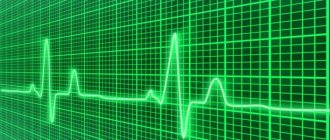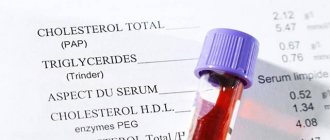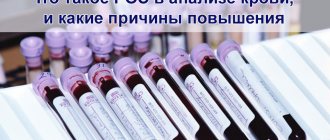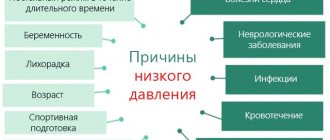Normal pressure readings are 120 to 80 mmHg. Art. These values change under the influence of various factors: during excessive physical exertion, during periods of stress, during excitement, in the heat. There are many factors influencing changes in blood pressure parameters; a slight change up or down does not indicate serious pathologies. When identifying cardiovascular abnormalities, doctors look at pulse pressure (PP). PD refers to the difference between the upper and lower values. This is a key factor that indicates violations.
What is pulse pressure
Pulse pressure is the difference between systolic and diastolic values. To calculate PD, you need to subtract the lower value from the upper value. The result will be pulse pressure.
The formula looks like this:
Systolic value – Diastolic value = Pulse pressure .
There is a standard pulse pressure that specialists rely on when making a diagnosis. Pulse pressure normally ranges from 40 to 60 points. Deviations from this value are permissible, but they cannot be more than 10 units.
Pulse pressure should not depend on arterial values on the tonometer. When blood pressure surges, the difference between the upper and lower values should remain unchanged.
Pulse pressure is the difference between the upper and lower readings
Normal blood pressure in children and adolescents
| Childhood | Up to a year | One year | 3 years | 5 years | 6-9 years | 12 years | 15 years | 17 years |
| Girls blood pressure mmHg | 69/40 | 90/50 | 100/60 | 100/60 | 100/60 | 110/70 | 110/70 | 110/70 |
| Boys BP mmHg | 96/50 | 112/74 | 112/74 | 116/76 | 122/78 | 126/82 | 136/86 | 130/90 |
How to find out what blood pressure should be in small children? Blood pressure levels in children differ significantly from those in adults. As a rule, it depends on the gender, weight and height of the child.
The average blood pressure in a child is calculated using a special formula:
- Upper systolic blood pressure: number of years × 2 80 (age multiplied by two and added eighty);
- Lower diastolic blood pressure: number of years 60 (age plus sixty).
Increasingly, doctors began to diagnose high blood pressure in newborns. This is the cause of various vascular and heart diseases.
What indicators are considered normal?
Pulse pressure can normally fluctuate between 40-60 units. There is no general indicator, since this is an individual value for each person. The normal pulse pressure changes over the years. In youth, the PD value will be 40-45 units, in adults it is 50 points, and in adulthood it will reach 60 points.
The maximum value of pulse pressure is observed at 50-60 years of age, then the indicator decreases. Changes in PD are influenced by hormonal levels.
Table of pulse pressure by age:
| Age limits | Average PP for men | Average PD for women | Normal blood pressure indicators for men | Normal blood pressure indicators for women |
| 20 | 45 | 43 | 123/76 | 116/72 |
| 21-30 | 51 | 44 | 126/79 | 120/75 |
| 31-40 | 47 | 46 | 129/81 | 127/80 |
| 41-50 | 51 | 52 | 135/83 | 137/84 |
| 51-65 | 50 | 51 | 142/85 | 144/85 |
| Over 65 | 45 | 47 | 142/80 | 159/85 |
The table is compiled based on many years of research. Deviations from the table are permissible within minor limits.
Calculation formulas
First formula: (2 ×DAD SAD) ÷ 3
Diastolic blood pressure is multiplied by 2, systolic blood pressure is added, and the result is divided by 3.
With indicators of 120/80, the calculations look like this: (2 × 80 120) ÷ 3 = 93 mm Hg. Art.
Diastolic blood pressure is subtracted from systolic blood pressure, the difference is divided by 3, and diastolic blood pressure is added to the result.
Calculation based on indicators 120/80: (120 – 80) ÷ 3 80 = 93 mm Hg. Art.
(0.42 × SBP) (0.58 × DBP)
The upper pressure is multiplied by a factor of 0.42; lower - by 0.58. The works are added up.
Calculation using the example of blood pressure 120/80: (120 × 0.42) (80 × 0.58) = 96.8 mm Hg. st
The result of calculations using this formula is less accurate than in the first two options.
In hospitals, a person’s average pressure is calculated using the formula: CO × OPSS.
Causes of high pulse pressure
Pulse pressure reflects disturbances in the functioning of the cardiovascular system. High pulse pressure can be caused by a number of factors:
- increase in temperature, overheating of the body: the systolic value increases, which leads to an increase in the difference in values;
- inflammatory processes in individual structures of the heart muscle caused by infections or autoimmune reactions, inflammation of the inner lining of the heart, myocardial damage;
- congenital or acquired heart defects;
- long-term drug therapy for hypertension: a high difference between the upper and lower values will be a protective reaction of the body;
- kidney failure;
- ischemia, heart failure;
- hyperfunction of the thyroid gland;
- atherosclerotic vascular lesions;
- lack of vitamins in the body.
As body temperature rises, the difference between upper and lower pressure also increases.
Blood pressure control
The highest blood pressure is in the aorta, and as you move away from it, the pressure in the arteries decreases. The lowest blood pressure in the veins! It depends on the volume of blood entering the arteries as a result of the work of the heart and the diameter of the lumen of the vessels.
High blood pressure destroys blood vessels and damages arteries. Being in this state for a long time, a person is at risk of: cerebral hemorrhage; failure of the kidneys and heart.
Why does blood pressure rise? Most often this is due to lifestyle. Many professions force a person to remain in one position for a long period of time, and for proper blood circulation it is necessary to move. Conversely, people who work in hard and physical jobs often overload the body, which cannot cope with the movement of blood flow in the vascular system.
Another important reason may be stress and emotional disorders. A person who is completely absorbed in work does not even notice that he has high blood pressure. This is due to the fact that the brain is constantly busy with tasks, and the body has little rest and relaxation.
Hypertension is often caused by bad habits. For example, alcohol and smoking. This is not surprising, since alcohol and tobacco destroy the walls of veins and vessels through which blood flows.
Why does pulse pressure drop?
Low pulse pressure is the difference between the upper and lower values of less than 40 units. In this case, doctors diagnose isolated arterial hypotension.
The causes of low human pulse pressure are always caused by pathologies:
- Ischemic nephropathy caused by vascular stenosis. Pulse pressure is regulated by biochemical mechanisms. The body produces the enzyme renin, which regulates vascular tone and the blood supply system. When kidney function is impaired, an imbalance occurs in metabolism, organ nutrition, and synthesis. This leads to a change in the glomerular filtration rate, impaired blood flow, and general destabilization. If left untreated, the condition can worsen and lead to a heart attack or severe kidney failure. Due to disorders occurring in the kidneys, the arterial value increases, which is reflected in the pulse value.
- Myocardial infarction. In case of acute disruption of blood supply, tissues and cells die. This is reflected in the value of pulse pressure, which decreases sharply. arterial parameters also drop to critical values.
- Extreme degree of left ventricular failure. Due to a sharp decrease in arterial parameters, failure develops in the left ventricle of the heart muscle. Factors influencing the development of the disorder are different: from aortic valve stenosis to a heart attack. Without medical intervention, a person can die.
- Heavy bleeding. Blood loss leads to a sharp drop in blood and pulse pressure. This is a protective reaction of the body, which tries to preserve tissue nutrition. Internal organs and vital systems do not receive sufficient nutrition and blood supply, which can lead to necrosis.
- Decompensation of chronic heart failure.
- Damage to the hypothalamus.
- Vegetovascular dystonia.
- A sharp decrease in cardiac output and cerebral ischemia.
A sharp decrease in pulse blood pressure can lead to death, so therapeutic intervention is required.
The lower the pulse pressure indicator, the greater the problems with the person’s condition it indicates
Reasons for deviations
High or low pulse pressure can be caused by the following factors affecting the human body:
- smoking;
- alcoholism;
- inactive lifestyle;
- lack of essential microelements and primarily iron;
- frequent stress;
- overwork;
- lack of sleep;
- obesity;
- starvation;
- physical fatigue;
- unbalanced diet;
- lack of fluid in the body;
- hereditary predisposition;
- During pregnancy and breastfeeding;
- feverish condition;
- consuming excess salt;
- malignant neoplasms;
- diabetes;
- cardiosclerosis or coronary heart disease;
- valve defects;
- hypertonic disease;
- increased intracranial pressure;
- renal failure;
- hormonal imbalance;
- thyrotoxicosis.
Symptoms of abnormalities
Deviations from the average pulse pressure can be determined by the appearance of characteristic symptomatic signs:
- pain in the head: throbbing pain in the back of the head in time with the heart rhythm;
- dizziness: loss of orientation in space, vestibular disorders, vertigo;
- vomiting: reflex vomiting, which does not bring relief, the feeling of nausea is caused by insufficiency of cerebral blood supply;
- increased sweating: the body receives false signals that force it to start thermoregulation, it produces more sweat due to imaginary cooling;
- clouding of consciousness: disorientation, auditory and visual hallucinations, memory loss, prosopagnosia;
- blue discoloration of the skin around the mouth;
- speech impairment, unintelligibility;
- unsteady gait;
- paralysis, lack of coordination of movements.
These are the main symptoms of dangerous pulse pressure that occur most often. The list of disorders is much wider.
Specific problems and their solutions
To improve the condition of blood vessels under the condition of progressive atherosclerosis and increased “bad” cholesterol in the blood, the patient must take a complex of drugs according to the regimen.
Among them:
- Statins – prevent atherosclerosis;
- Antispasmodic medications;
- Ca channel blockers;
- Ion exchange resins;
- A nicotinic acid;
- Agents that stimulate myocardial tone.
Each group of products has its own spectrum of action. The combination, or rather its choice, is always up to the doctor. This depends on the individual characteristics of the patient’s health status, blood pressure and pulse pressure, and existing chronic diseases. If you are a supporter of traditional medicine, still check with your doctor for each recipe you intend to use.
Why are such conditions dangerous?
High and low pulse pressure values are dangerous to human health. Main risks and possible complications:
- a heart attack leading to acute heart failure, which can lead to sudden death;
- acute cerebrovascular accident, which is caused by rupture of a vessel or death of nerve cells, which can be fatal;
- heart failure syndrome;
- ischemia;
- syncope, which can lead to serious internal pathologies or death;
- impaired renal function due to damage to one organ;
- dementia, cognitive disorders, impaired mental activity, high risk of developing schizophrenia, Alzheimer's disease.
If signs of pulse abnormalities appear, you should consult a doctor who will select treatment appropriate to the indications.
If the difference between the upper and lower values is high, the likelihood of complications and severe consequences is much higher.
High pulse pressure can be very dangerous
What will make the current situation worse?
The heart and blood vessels create a system that is very sensitive to the lifestyle that you lead. Not a single bad habit will go unnoticed by her. A variety of factors provoke pressure surges. But it’s one thing when they occur rarely, one-time, but it’s quite another thing if they make up your way of life.
These factors can be divided into:
- External. These include obesity (a provocateur of many somatic diseases), physical inactivity, iron deficiency anemia, chronic stress, fasting and exhausting diets, overwork, increased anxiety, and sudden weight loss. These also include bad habits - smoking and drinking, overeating, destabilization of sleep patterns.
- Internal. This list includes diabetes mellitus, cardiosclerosis, heart block, dermatitis, adrenal burnout, endocrine abnormalities, liver cirrhosis, serious allergic reactions, etc.
People with the above ailments should not only be attentive to their health: they need to understand that their illness makes adjustments to their lifestyle. And you shouldn’t resist this; you need to calmly change your routine, habits, and sacrifice something for the sake of maintaining your health. And the goal of all this is to improve the quality of life, and not self-destruction, as is often the case.
How to relieve the condition at home?
If pulse pressure increases or decreases, you must call an ambulance. It is impossible to normalize the condition and help the patient at home.
Before the ambulance arrives, you must follow the general recommendations:
- You should not take pills for hypertension or hypotension without a doctor’s prescription; taking medications not according to indications can lead to a worsening of the condition; before prescribing medications, the doctor will conduct a comprehensive examination, determine the cause of the disease, the severity of the problem, and then draw up a therapeutic treatment plan;
- if pulse pressure is disturbed, the patient should not be allowed to drink or eat, this can lead to loss of consciousness and involuntary vomiting; in this state, the patient may choke on vomit;
- to normalize the condition, you need to take a comfortable position, calm down, take a few deep breaths and exhales, think about the good;
- in the room you need to open a window or window to ensure the flow of fresh air into the room, you need to remove tight clothes from your body, unfasten the collar.
Upon arrival of the ambulance team, you must describe your condition in detail, as well as follow all the recommendations of medical workers. Specialists will provide first aid and decide whether hospitalization is necessary.
First aid and further actions for a patient with bradycardia and hypotension
The algorithm of action depends on the frequency of occurrence of symptoms, their intensity and the cause of low blood pressure and frequent low pulse. Typical clinical picture: headache, dizziness, drowsiness in the middle of the day, loss of consciousness, nausea; Vomiting, cold sweat, shortness of breath, and swelling may occur.
Treatment primarily depends on the severity of the symptoms. This can be found out by visiting a doctor. The range of possible diagnostic procedures includes anamnesis, objective examination (measurement of pulsation, pressure, assessment of the state of the cardiovascular system), general tests (possible anemia, which is manifested by a lack of hemoglobin and red blood cells), ECG, Holter monitoring, chest x-ray and additional studies depending on comorbidities.
If this condition does not cause much discomfort, you can take a cup of strong green tea for low blood pressure and low pulse. This increases blood pressure and tones blood vessels. A variety of tinctures have a positive effect: ginseng, belladonna, eleutherococcus.
For chronic cases, medications are used: Citramon, Zelenin tincture.
There is a special conduction system in the heart that ensures the excitability and automaticity of the heart. Contractions above 60 times per minute are provided by the sinus node (which normally plays the role of a first-order pacemaker). When it weakens, the underlying structures perform the pacemaker function, which contributes to bradycardia. For this pathology, surgical intervention and installation of an electrical pacemaker are adequate, which ensures the heart rate at the required level.
You should not forget to monitor your pulse and blood pressure during an attack, since a decrease in heart rate (HR) below 40 is fraught with cardiac arrest, so readings less than 50 or resistance to home treatment are indications for calling an ambulance.
Critical conditions that may be accompanied by hypotension and bradycardia:
- Pulmonary embolism (blockage of a vessel with a blood clot, resulting in acute respiratory failure). In such a case, it is necessary to carry out anticoagulant therapy with heparin or its analogues, thrombolytic therapy (streptokinase, alteplase) and treatment of hemodynamic and respiratory disorders. At the same time, the ability of blood to clot is recorded. To verify the diagnosis, X-rays are taken and D-dimer is measured.
Loss of consciousness and collapse (a critical decrease in blood pressure that requires immediate medical attention and can lead to failure of internal organs). In this case, it all depends on the reason that provoked the attack. First aid is to place the person in a lying position (if this is not already done) and elevate the legs to increase blood flow to the head. Next, drugs such as caffeine-sodium benzoate, mezatone, and adrenaline can be administered. In case of hemorrhagic collapse, it is necessary to stop the bleeding and begin administering blood substitutes, and in case of infectious collapse, infusion therapy, detoxification and elimination of the pathogen are carried out;- Severe allergic reactions (for example, angioedema). These conditions are treated with adrenaline or glucocorticoids, depending on the etiology;
- Condition during anesthesia. Hypotension and bradycardia are common side effects of spinal anesthesia. The main effects are a decrease in preload on the heart, which is combined with bradycardia. Here it is necessary to reduce the depth of anesthesia and replenish the volume of circulating blood. Doctors sometimes resort to the use of vasopressors, atropine and antiarrhythmics - heavy cardiac artillery;
- Myocardial infarction. This pathology requires urgent medical attention. During an attack, there is typical chest pain radiating to the left side of the body. The symptom does not go away and is not relieved by nitroglycerin, the person feels anxiety and fear of death.
Further tactics are to normalize the daily routine, sleep and rest. Eliminate stress and overload, and adequate physical activity, on the contrary, will help improve your condition. You should eat often, in small portions, and drink enough fluids. It is recommended to eat seaweed, seafood, and nuts. A dairy-vegetable diet will be beneficial. The patient should limit the consumption of baked goods and fatty foods.
Diagnostic measures
To diagnose a pulse pressure disorder and the cause of its occurrence, you need to consult a therapist. The therapist will conduct a general examination and write a referral to a cardiologist, endocrinologist, neurologist, nephrologist. A comprehensive examination will help to accurately determine the cause of the deviation of pulse pressure from normal values. After a comprehensive examination, the doctor will prescribe appropriate treatment according to indications.
Diagnostic methods:
- neuromonitoring, checking the functioning of the kidneys and thyroid gland;
- physical diagnosis;
- collecting information about the development of the disease, concomitant diseases, and other abnormalities;
- measuring blood pressure using a tonometer;
- continuous recording of heart dynamics on ECG throughout the day;
- ECG;
- Ultrasound of the heart;
- Doppler examination of the vessels of the neck and head;
- analysis of thyroid hormones;
- Ultrasound of the kidneys;
- clinical urine analysis;
- general blood analysis;
- blood chemistry.
The types of diagnostic tests are determined by the attending physician after assessing the general condition of the patient.
ECG is one of the most accessible diagnostic methods
Normal blood pressure in adults
Normal blood pressure in an adult is 120/80 mm Hg.
Art. A reading of 120 is the upper systolic blood pressure, and 80 is the lower diastolic. High blood pressure is considered to be a maximum upper blood pressure of 140 mm Hg. and higher, and the minimum diastolic blood pressure is 90 mm Hg. and higher.
table of blood pressure norms for people over 18 years of age
| Meaning | Upper blood pressure (mm Hg) | Lower blood pressure (mm Hg) |
| The best option | 120 | 80 |
| Normal pressure | Less than 130 | Less than 85 |
| High | From 130 to 139 | From 85 to 89 |
| 1 degree hypertension | From 140 to 159 | From 90 to 99 |
| 2nd degree – moderate | From 160 to 179 | From 100 to 109 |
| 3rd degree - severe | ≥ 180 | ≥110 |
Blood pressure indicators for an adult
Blood pressure is one of the main parameters of the system. It, unlike atmospheric, is measured in millimeters of mercury, and not in pascals.
There are two blood pressure indicators:
- Systolic blood pressure (SBP) is the level of blood pressure at the moment of maximum contraction of the heart. It is created by left ventricular stroke volume, ejection velocity, elasticity and aortic diameter. Normal values are 100-139 mmHg.
- Diastolic blood pressure (DBP) - displays the pressure at the moment of greatest relaxation. DBP depends on the duration of diastole and TPVR - total peripheral vascular resistance. The DBP value is 60-89 mmHg.
The invasive (direct) method of measuring blood pressure is applicable exclusively in hospital settings, for example, during operations and in the intensive care unit. For continuous monitoring, a catheter with a sensor is inserted into the radial artery (at the wrist), and the data is displayed on the monitor. Despite the undeniable assistance in conditions where a person is in serious condition, thrombosis, bleeding and infection of the puncture site may occur.
Among doctors and ordinary users, non-invasive devices and methods are common that make it possible to quickly, without causing discomfort and bloodlessly determine the level of a patient’s blood pressure.
| Palpation method | It consists of gradually compressing and relaxing the limb with a cuff in the area of the artery, and palpating it below the point of compression. SBP is determined by the pressure on the manometer at which pulsation begins, diastolic - at the moment when it disappears. |
| Auscultatory method | Invented in 1905 by N.S. Korotkov, and has not changed since then. To carry out the measurement, a sphygmomanometer and a phonendoscope are required. The principle of the method is identical to palpation, only the appearance or disappearance of the pulse is heard. |
| Oscillometric method | The device of electronic tonometers is based on this technique. With its help, you can measure pressure at any point in the artery, including the wrist, and without the participation of a second person, which makes portable mini devices popular. With a gradual decrease in pressure in the cuff, oscillations (oscillations) occur in it, which correspond to the pulsation of the vessel under it. They appear when air tension decreases to the level of SBP and disappear when it is compared with DBP. |
In everyday practice, the auscultatory method according to the Korotkov technique is considered the most accurate and convenient. Mechanical phonendoscopes are not expensive and are found in almost every family, which allows you to control the blood pressure for yourself and your loved ones.
The advantages of the technique are resistance to rhythm disturbances and hand movements during the study. However, this technique is sensitive to ambient noise and the need for precise positioning of the phonendoscope membrane over the artery. Since the method requires human intervention, the measurement error can range from 7 to 15 mmHg.
Modern cuffs are available in different sizes, allowing you to measure the pressure of both a newborn and a very obese person.
Calculation formulas
Modern methods for calculating average blood pressure:
- MAP = DBP (SBP - DBP)/3
- MAP = 2/3 (DBP) SBP/3
- MAP = [(2xDBP) SBP]/3
where MAP is mean arterial pressure
DBP – diastolic blood pressure
SBP – systolic blood pressure
There is a fourth formula that uses pulse blood pressure (PBP), obtained by subtracting DBP from SBP. It represents the force the heart generates with each contraction.
- MAP = DBP PAD/3
Formula for calculating blood pressure by age:
- SBP = 109 (0.5 × age) (0.1 × weight);
- DBP = 63 (0.1 × age) (0.15 × weight).
At the moment, these calculations are not relevant, since the World Health Organization and the American Heart Association have approved blood pressure standards for people aged 12 years and older.
Convenient tables have been developed for children that take into account age, gender and SBP and DBP values.
Such a number of formulas derived by scientists suggests that average blood pressure is of great importance in clinical practice. Despite the fact that at the moment many online calculators and mobile applications have been developed that calculate its value, manual calculation is still popular and brings its undeniable benefits. Every doctor knows how to calculate blood pressure.
Normal average blood pressure is from 70 to 110 mmHg.
Higher numbers are an indication that the heart is working harder than it should. A high MAP is observed in heart failure and myocardial infarction.
Low MAP can be fatal if left uncorrected. With numbers below 60 mmHg. organs do not receive the required amount of blood, and a state of shock develops. MAP falls with sepsis, blood loss, stroke and polytrauma.
PD indicator is below normal
Pulse pressure is considered extremely low if it is less than 25% of the systolic (upper) pressure. If such a pathological process lasts long enough, then negative changes begin in the structure of the brain, vision also deteriorates, and the nervous system also reacts. The person becomes weak and dizzy, and finds it difficult to concentrate and perform any duties.
Low PP develops quite quickly in diseases such as:
- Heart valve stenosis;
- VSD (vegetative-vascular dystonia);
- Anemia.
How to lower blood pressure at home
If your blood pressure periodically rises, there is no need to wait for crises and threatening conditions. Consult a doctor at the stage of the disease when everything can be resolved conservatively and, if possible, gently. There is no need to look for miracle recipes on how to lower pulse pressure at home simply and without drugs. Do not experiment on yourself - many folk recipes can be harmful.
However, some recommendations will work without medical confirmation. For example, reducing the amount of coffee and black tea you drink daily. Caffeine can be both a medicine and a poison. It's a matter of moderation and understanding how to drink coffee correctly.
Hypertensive patients should keep an infusion of valerian or lemon balm or peony at home. You need to have light sedatives on hand - you can take them as a course or situationally. They rather play the role of preventing high blood pressure. But if it has risen slightly, then that is enough to return to normal.
Also known heart stimulants are rosehip and hawthorn. These plants generally improve blood flow and help the heart cope with stress. Valerian root and flaxseed have a calming effect. But this is in case of a sudden slight increase in pressure. If it is persistently high, drug therapy is needed.











